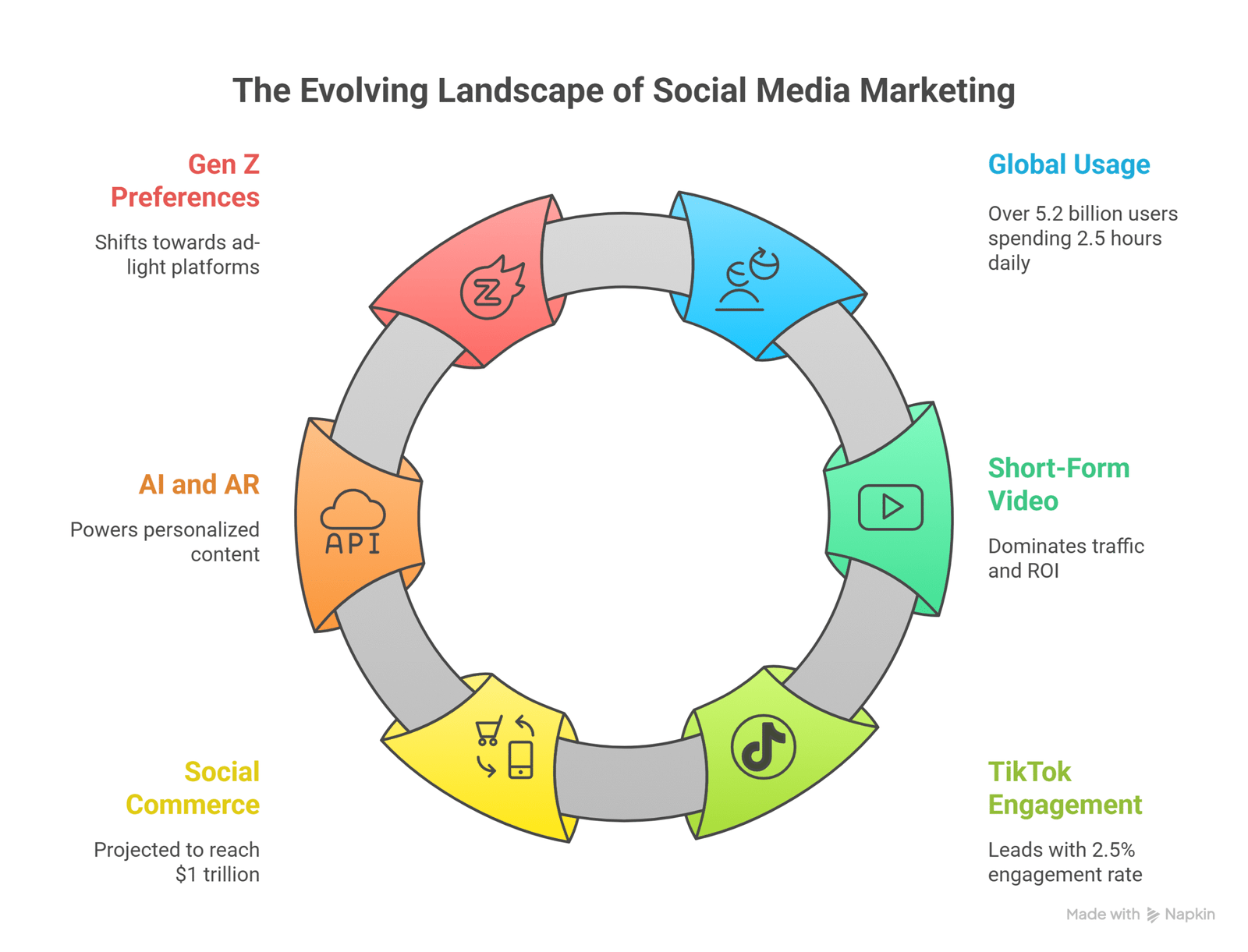What is Social Media in Digital Marketing?
Introduction
Scroll back just fifteen years, and digital marketing was largely about emails, banner ads, and websites. Fast-forward to today, and it’s impossible to ignore the role that social media platforms play in shaping how brands speak, engage, and sell. From TikTok trends to LinkedIn thought leadership posts, the evolution of digital marketing has been radically reshaped by the explosion of social media.
So, what is social media in digital marketing?
At its core, social media in digital marketing refers to the strategic use of social media platforms—like Instagram, Facebook, LinkedIn, X (formerly Twitter), and TikTok—to promote products or services, engage with target audiences, and strengthen brand visibility online. It’s more than just posting pictures or memes; it’s about aligning your brand voice, content, and campaigns with a broader digital marketing strategy that delivers measurable results.
As modern consumers spend increasing hours scrolling, watching, and interacting online, businesses have shifted their marketing approach to meet audiences where they are—on social media platforms. This shift has transformed social media from a casual connection tool into a powerhouse of digital influence. It now plays a central role in how brands attract attention, foster trust, and drive revenue.
In short, social media in digital marketing isn’t a side dish—it’s the main course in many high-performing brand strategies today.
Understanding Social Media in Digital Marketing
To truly grasp the power of social media in digital marketing, it’s essential to understand what it does beyond the likes and shares. At its heart, it’s the art and science of using social media platforms to connect with your audience, communicate your brand’s message, and convert attention into action.
Social media in digital marketing isn’t just about presence—it’s about purpose. Businesses craft and share content that resonates with their audience through channels like Facebook, Instagram, TikTok, LinkedIn, and X. This content can range from viral videos and branded images to polls, live streams, stories, and behind-the-scenes sneak peeks. Each post isn’t just a message; it’s a strategic move in a larger digital marketing strategy designed to increase engagement, traffic, and conversion.
What makes social media platforms uniquely valuable is their ability to foster two-way interaction. Unlike traditional advertising, social media allows brands to listen, respond, and evolve in real time. Whether it’s replying to a comment, participating in trending conversations, or handling customer service via direct message, businesses that understand this dynamic are the ones building loyal online communities.
Modern tools—like scheduling dashboards, real-time analytics, and content performance insights—make managing a brand’s social media presence more precise and data-driven than ever. It’s not guesswork; it’s guided by performance metrics, audience behavior, and strategic alignment with overall business goals.
In essence, social media in digital marketing is about leveraging digital conversations to create real-world business impact. It’s the bridge between a brand and its audience—immediate, interactive, and increasingly indispensable.
6 Core Roles of Social Media in a Digital Marketing Strategy
In today’s hyper-connected world, a strong digital marketing strategy isn’t complete without the integration of social media platforms. These platforms do more than just host content—they shape brand perception, spark conversations, and drive results. Below are the essential roles social media in digital marketing plays in transforming how businesses grow and engage.
A. Building Brand Awareness
Visibility is currency—and social media spends it well. By consistently sharing valuable, entertaining, and authentic content, brands can increase recognition and reach audiences far beyond their geographic limits. Platforms like Instagram and TikTok offer visual storytelling, while X and LinkedIn amplify thought leadership.
A solid social media marketing strategy ensures your brand appears where your audience is already paying attention. Over time, this consistent presence builds trust, familiarity, and relevance—all pillars of strong brand awareness.
Fact: According to Sprout Social, 68% of consumers follow brands on social media to stay informed about new products and services.
B. Targeted Advertising
Gone are the days of one-size-fits-all marketing. Social media in digital marketing offers advanced targeting capabilities that let businesses speak directly to their ideal customers. Want to reach millennial dog lovers in Austin who’ve recently searched for grooming services? Facebook Ads has you covered.
Through behavioral data, interests, location, and even device usage, businesses can design hyper-specific campaigns that improve conversion rates and deliver better ROI.
Insight: Targeted social media ads can reduce wasted spend and increase ad relevance—two major wins in any digital marketing strategy.
C. Boosting Customer Engagement
Social media isn’t just a billboard—it’s a conversation. From replying to comments to sharing user-generated content (UGC), brands can build authentic connections with their audiences. Features like Instagram Stories’ polls, Q&A stickers, and LinkedIn’s comment threads all deepen engagement.
High engagement signals to algorithms that your content is valuable, extending your reach and influence. More importantly, it shows your audience that you’re listening—and that matters.
Pro Tip: Engaged followers are more likely to become loyal customers and advocates.
D. Driving Website Traffic
A well-placed link in a post, story, or profile can act as a direct pipeline to your site. Whether you’re promoting a blog, product page, or lead magnet, social media is a critical channel for driving high-quality traffic.
Smart CTAs (calls to action), captivating captions, and timely content boosts the chances that users will click through—contributing to sales, signups, or other business goals. And with UTM tracking, you can measure the exact impact of every click.
SEO Bonus: Traffic from social platforms signals relevance to search engines, helping improve organic rankings.
E. Data and Analytics for Smarter Decisions
One of the hidden superpowers of social media in digital marketing is its analytics. Tools like Meta Business Suite, LinkedIn Analytics, and third-party platforms provide real-time insights into who’s engaging with your content, what’s working, and what needs a pivot.
This data helps marketers refine their strategy, optimize content, and scale what works—all backed by measurable proof.
Takeaway: In digital marketing, guessing is risky. Data leads to smarter, faster, and more profitable decisions.
F. Influencer Marketing Integration
Welcome to the age of influence. Collaborating with influencers—creators who’ve built trust and followings—can introduce your brand to new audiences with credibility and impact. Influencer partnerships humanize your brand and give it a voice outside your own.
Whether it’s a niche micro-influencer or a big-name creator, the right collaboration can drive awareness, sales, and viral moments. The key is alignment: values, tone, and audience fit.
Trend Alert: Influencer-generated content often outperforms brand-created ads in both reach and engagement.
In short, the roles of social media in digital marketing go far beyond visibility—they shape relationships, sharpen targeting, and amplify results. When integrated strategically, they become the cornerstone of a resilient, future-proof marketing approach.
5 Social Media Trends and Best Practices in 2025

Social media in digital marketing is anything but static. It’s a high-speed, ever-evolving ecosystem where trends shift overnight and attention spans shrink by the second. To thrive in this space, brands need to stay ahead of the curve—not just follow it.
Here’s what’s shaping the landscape in 2025 and how businesses can turn trends into tangible results.
1. The Rise (and Reign) of Short-Form Video
If content is king, short-form video is the crown jewel. Platforms like TikTok, Instagram Reels, and YouTube Shorts dominate user attention. With engaging visuals, music overlays, and rapid storytelling, these videos pack punch in seconds—and convert like crazy.
Best Practice: Make videos snackable, value-driven, and authentic. Think tutorials, behind-the-scenes peeks, and customer reactions. Raw often beats polished.
Keyword tie-in: short-form video content, video marketing strategy, social media platforms
2. Influencer Marketing Is Getting Smarter
No longer just about celebrity shoutouts, influencer marketing is becoming data-driven, niche-focused, and strategy-rich. Brands are partnering with creators whose audiences actually convert—not just scroll and swipe.
Sign up today for our weekly newsletter sent straight into your inbox
Micro- and nano-influencers are seeing increased demand for their ability to deliver engagement over vanity metrics.
Pro Tip: Track influencer ROI just like paid media. Engagement rates, conversions, and sentiment analysis matter more than follower counts.
Keyword tie-in: influencer marketing trends, social proof, brand engagement
3. Edutainment is the New Engagement
Educational + entertaining = edutainment. Audiences are craving content that teaches while it entertains. From quick how-tos to “Did you know?” facts, brands that can inform and delight are winning attention and trust.
Best Practice: Use storytelling to simplify complex topics, show expertise, and position your brand as a go-to resource.
Keyword tie-in: engaging social media content, content strategy, digital marketing success
4. Consistency Is the Secret Sauce
Going viral is great. Being predictably visible is better. Posting regularly and engaging actively with your audience builds momentum, feeds the algorithm, and establishes trust. In 2025, consistency beats flash.
Scheduling tools and content calendars are must-haves for executing this effectively across multiple social media platforms.
Golden Rule: Show up daily. Not perfectly—just consistently.
Keyword tie-in: social media strategy, posting schedule, brand visibility
5. Analytics Are No Longer Optional
Gut instinct is great for creativity—but data drives decisions. With built-in analytics and AI-powered insights, marketers now have the tools to refine their digital marketing strategy in real time.
Track what content performs, which platforms convert, and when your audience is most active. Then adjust, amplify, or cut as needed.
Best Practice: Review performance weekly. Optimize monthly. Iterate always.
Keyword tie-in: social media analytics, data-driven marketing, performance tracking
In 2025, winning in social media in digital marketing means being agile, authentic, and algorithm-aware. It’s not about chasing every trend—it’s about showing up with purpose, value, and a deep understanding of what your audience craves.
Tools and Platforms for Social Media Marketing
You wouldn’t build a house without the right tools—and the same goes for managing a high-performing social media in digital marketing strategy. Whether you’re a solo creator or a full-scale brand team, having the right platforms and tools can turn effort into efficiency, and engagement into growth.
Let’s break down the essential players and digital allies you need in your marketing arsenal.
Top Social Media Platforms for Marketing
The first step? Choosing the right stages to tell your brand story. Each social media platform serves a unique purpose, audience, and content format:
- Instagram: Visual storytelling, influencer collaborations, and Reels dominate. Ideal for lifestyle, fashion, food, wellness, and e-commerce.
- Facebook: Great for community-building, ads with deep targeting, and reaching older demographics. Still a giant in the digital space.
- LinkedIn: The go-to platform for B2B, thought leadership, professional services, and recruitment campaigns.
- X (formerly Twitter): Best for real-time news, brand voice development, and trend jacking.
- TikTok: Home of short-form video creativity and unmatched organic reach—especially powerful for Gen Z and millennial targeting.
- YouTube: Long-form video, tutorials, product demos, and evergreen content. Pairs well with SEO for long-term discoverability.
Tip: Don’t try to master them all. Choose 2–3 platforms where your audience is most active and go deep.
Keyword tie-in: social media platforms, social media in digital marketing, content distribution channels
Essential Tools for Social Media Management
Your content might be gold—but if it’s disorganized, unmeasured, or inconsistently posted, you’ll struggle to scale. These tools streamline the process and supercharge your digital marketing strategy:
Content Scheduling & Publishing
- Buffer, Later, Hootsuite, Sprout Social
- Schedule posts in advance across multiple platforms.
- Maintain consistency and improve timing with analytics-backed suggestions.
Analytics & Reporting
- Meta Business Suite, LinkedIn Analytics, Google Analytics, Sprout Social
- Track what’s working: impressions, click-through rates, engagement, conversions.
- Set KPIs and compare performance across platforms.
Design & Content Creation
- Canva, Adobe Express, CapCut
- Create branded visuals, video clips, and infographics—even without a design team
-
FlexCip
- Flexclip
- Perfect suit for AI videos, Text to Speech, AI Script Generation and lots more.
- Flexclip
💬 Social Listening & Engagement
- Brand24, Mention, Sprinklr
- Monitor brand mentions, hashtags, and sentiment in real-time.
- Engage with audiences, handle feedback, and spot opportunities.
Pro Tip: Automate what you can, but never automate authenticity. Use tools to free up time for real engagement.
Keyword tie-in: social media tools, marketing automation, content scheduling
In today’s digital landscape, the combination of the right social media platforms and strategic tools gives you the edge. It’s how you transform creative sparks into scalable campaigns—and how social media in digital marketing becomes not just possible, but powerful.
6 Challenges and Considerations
While social media in digital marketing offers immense opportunities, it’s not all smooth scrolling. Behind every viral campaign and perfectly curated feed lies a series of calculated decisions, real-time pivots, and unavoidable hurdles. Knowing these challenges upfront empowers brands to plan smarter and execute stronger.
1. Constant Algorithm Changes
One week your content is everywhere; the next, it’s buried. Welcome to the algorithm shuffle. Social media platforms are constantly tweaking how content is ranked, served, and promoted. What worked last quarter may flop today.
Solution: Stay adaptable. Monitor algorithm updates via platform blogs, test content formats regularly, and diversify across platforms to reduce dependency on any single feed.
Keyword tie-in: social media platforms, digital marketing strategy, algorithm changes
2. Content Fatigue and Oversaturation
Let’s face it—everyone’s posting. In 2025, audiences are bombarded with content daily, from dancing videos to deep-dive carousels. Breaking through the noise requires more than volume; it requires value.
Consideration: Prioritize quality over quantity. Focus on relevance, creativity, and storytelling. Use social media in digital marketing to connect, not just promote.
Keyword tie-in: content fatigue, engaging social media content, brand messaging
3. Managing Brand Voice Across Multiple Platforms
A joke that lands on TikTok might fall flat on LinkedIn. Each platform has its own language, etiquette, and audience expectation. Maintaining a consistent brand voice—without sounding robotic—across all touchpoints is no small feat.
Strategy Tip: Develop a tone guide that flexes across platforms. Stay authentic while tailoring your message to match the culture of each channel.
Keyword tie-in: brand identity, social media strategy, multi-platform marketing
4. Measuring Real ROI
It’s easy to count likes. It’s harder to calculate their value. Many marketers struggle to tie social media performance to actual business results like sales, lead quality, or customer lifetime value.
Insight: Use UTM codes, conversion tracking, and attribution models. Measure what matters—beyond the vanity metrics.
Keyword tie-in: social media ROI, performance metrics, data-driven marketing
5. Time and Resource Demands
Creating content, responding to DMs, staying on top of trends—it’s a full-time job (or three). For small teams, keeping up can lead to burnout or inconsistent execution.
Pro Tip: Repurpose long-form content into multiple short-form pieces. Use scheduling tools to batch posts. Automate, delegate, and rest.
Keyword tie-in: social media management, marketing tools, time-saving strategies
6. Reputation Management and Crisis Response
Social media gives everyone a voice—including unhappy customers. One bad review or viral misstep can damage brand perception in minutes.
Action Step: Build a crisis response plan. Monitor sentiment with social listening tools and respond quickly, respectfully, and transparently.
Keyword tie-in: brand reputation, social media engagement, customer feedback
While the challenges are real, they’re not insurmountable. In fact, overcoming them is what separates reactive brands from proactive leaders. With the right tools, mindset, and digital marketing strategy, social media in digital marketing becomes a channel not of chaos—but of calculated, creative impact.
Summary & Takeaways
So—what is social media in digital marketing? By now, it’s clear: it’s not just a tool. It’s the beating heart of modern digital communication, driving engagement, connection, and business growth at scale.
Through social media platforms like Instagram, Facebook, LinkedIn, TikTok, and X, brands can build powerful communities, speak directly to their audience, and turn scrolls into sales. But success requires more than presence. It demands a purpose-built digital marketing strategy, informed by data, powered by content, and driven by real human connection.
Let’s recap what we’ve uncovered:
- Social media in digital marketing empowers brands to increase visibility, deepen engagement, and create trust through content and conversation.
- From targeted advertising and influencer marketing to short-form video and real-time analytics, the tools and tactics have never been more dynamic—or more accessible.
- Challenges like content fatigue, algorithm shifts, and measuring ROI are real—but with smart tools, a strong voice, and clear goals, they’re entirely manageable.
- Success lies in consistency, creativity, and a relentless focus on audience value.
In a world where attention is currency, social media in digital marketing is how brands earn it—and keep it. Whether you’re a startup finding your voice or an enterprise scaling your reach, social media isn’t just where your audience hangs out. It’s where your brand becomes unforgettable.
Call to Action
- Ready to elevate your digital marketing strategy with smarter social media?
- Start by reviewing your current platforms, content, and performance.
- Then, align your goals with actionable tactics from this guide.
- Finally, stay agile, stay human, and stay consistent.
The digital world is listening. Make your message worth hearing.
Let’s Put Strategy into Action
Feeling inspired but unsure where to start? Whether you’re building your first campaign or refining a seasoned social presence, the right strategy makes all the difference.
- Need help crafting content that converts?
- Struggling to pick the right platforms for your audience?
- Looking to boost ROI with data-backed decisions?
Let’s work together to turn your social media into a growth engine.
Book a free strategy call or download our Social Media Marketing Starter Kit today — packed with platform checklists, content ideas, and planning tools to launch (or level up) your digital presence. Your audience is already online. Let’s make sure your brand meets them with purpose.
Frequently Asked Questions on What is Social Media in Digital Marketing?
What is social media in digital marketing?
Social media in digital marketing refers to the use of platforms like Facebook, Instagram, LinkedIn, TikTok, and X to promote products, engage with audiences, and drive business goals through strategic content and interaction.
Why is social media important in a digital marketing strategy?
Social media is essential because it boosts brand awareness, allows precise audience targeting, improves customer engagement, and drives traffic to your website—all key pillars of a successful digital marketing strategy.
Which social media platforms are best for digital marketing?
The best platforms depend on your audience. Instagram and TikTok work well for visual content and younger demographics, LinkedIn is ideal for B2B, and Facebook offers broad reach and robust ad targeting.
How do businesses measure social media ROI?
Businesses track metrics like engagement rate, click-through rate, conversions, and sales attributed to social campaigns using tools like Meta Business Suite, Google Analytics, and UTM parameters.
What are the latest trends in social media marketing for 2025?
In 2025, short-form video content, edutainment, influencer collaborations, and real-time engagement are dominating the social media marketing landscape.









